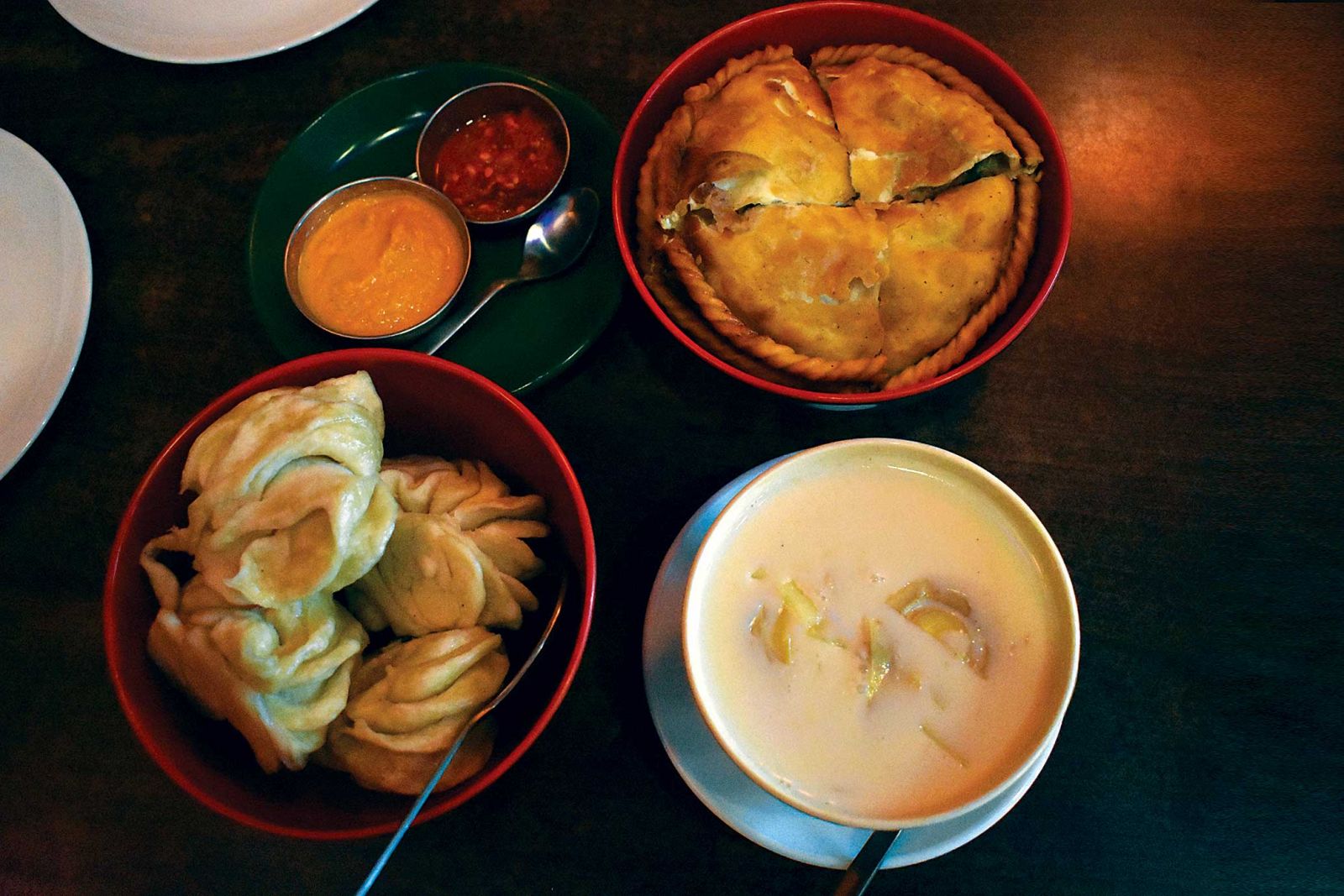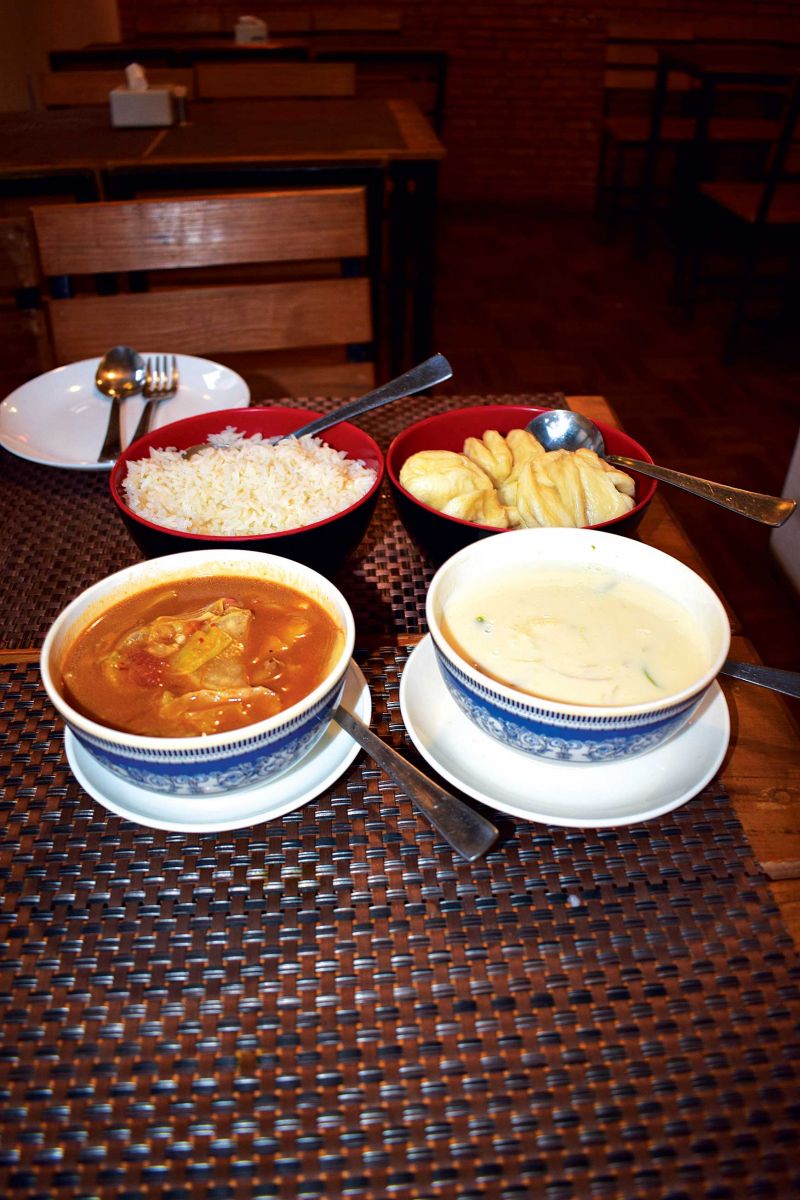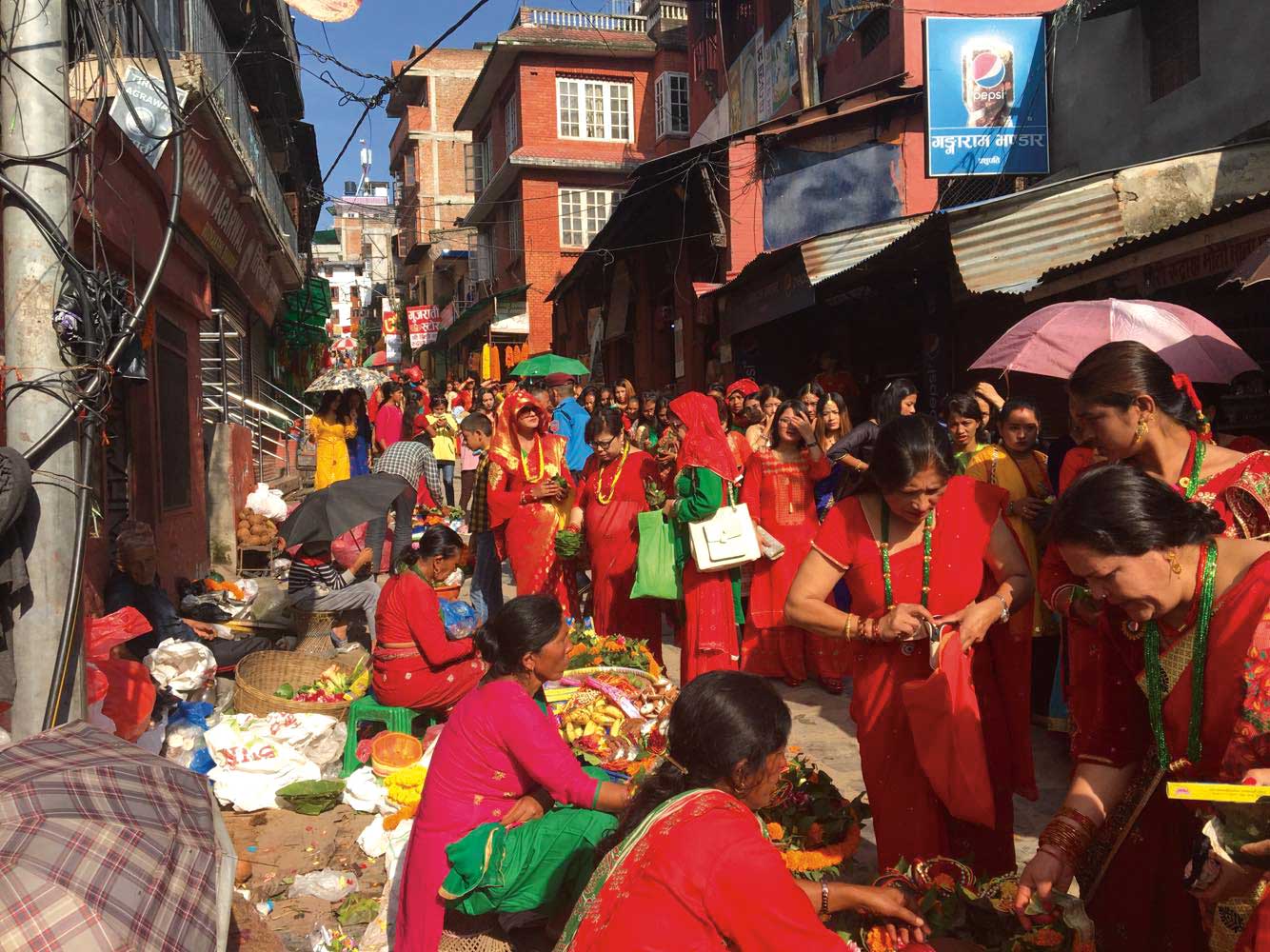 My early encounters with Bhutanese and Tibetan food were at the Dechenling Garden Restaurant, in Tridevi Marg. There, surrounded by delightful greenery, was where I first tasted crispy shabaley, thenthuk (rich with vegetables, meat, and hand-pulled noodles), barley soup, and ermadhatse. All were memorable and delicious, but ermadhatse was like nothing I’d ever had before. What was it? A cheese-based curry?Or something else? I don’t really know, but it’s wonderful: cheese, potatoes, mushrooms, onions, and slices of fresh green chilies in a white, creamy flavorful sauce all combined to make up something that shouldn’t work, but does.
My early encounters with Bhutanese and Tibetan food were at the Dechenling Garden Restaurant, in Tridevi Marg. There, surrounded by delightful greenery, was where I first tasted crispy shabaley, thenthuk (rich with vegetables, meat, and hand-pulled noodles), barley soup, and ermadhatse. All were memorable and delicious, but ermadhatse was like nothing I’d ever had before. What was it? A cheese-based curry?Or something else? I don’t really know, but it’s wonderful: cheese, potatoes, mushrooms, onions, and slices of fresh green chilies in a white, creamy flavorful sauce all combined to make up something that shouldn’t work, but does.
The Yak Restaurant in Thamel was another place I found years ago, and to which I return to often. I love to sit just to the left of the front door, tucked into a little booth, where I can watch the world go by outside while cozily sipping a giant tongbaand waiting for my food. Their thenthuk is also a favorite of mine, as are the momo and shabaley, and oh my goodness, their pork sweet and sour! But, their ermadhatse doesn’t quite hit the spot for me. As I’ve never been to Bhutan, I can’t say it’s not authentic—I have no clue whether it is or isn’t—but I don’t personally enjoy their version as much.
This has been on my mind, because as the evenings get a little nippy, this is the sort of food I crave. It shouldn’t be surprising, really, that chilly Himalayan countries should have food that is so comforting and warming. It goes without saying that Nepal has plenty such dishes of its own, but when it comes to food, there’s no reason to limit ourselves, so why not enjoy our neighbors’ food, too?
Sometimes, I wonder why some of the foods I’ve just mentioned aren’t more widespread. I’m not referring to those items that have become regulars in Nepal, such as shabaley fried up on a street cart, and of course, momo and thukpa, which can be found just about everywhere. No, what I was looking for was a good place to eat ermadhatse, that gooey, cheesey delight. And a few months ago, at a book reading event of all places, I had the serendipity to run into someone as fond of it as I was.
“There’s a little place in Lazimpat,” she told me. “They make great ermadhatse.”
“What? Really?Where?”
A few days later, following her directions, I ended up near the Hotel Shangri-La, opposite Trisara, where a sign read:
Majheri Restaurant & Bar: Bhutanese, Tibetian and Nepali Foods
If I’m honest, it did not look promising, not the restaurant nor the sign, but it turned out to be proof once again that you shouldn’t judge a book by its cover (or a restaurant by their signs) when looking for authentic food. They may not be able to spell, but it doesn’t matter, because they can cook. Boy, can they cook!
Since finding the Mu that day, I’ve practically become a regular, and when I’m not eating their food I want to be eating their food. I wish I could tell you I’ve worked my way through the menu, but I haven’t: since that first visit, I’ve ordered the same things nearly every time, with little variation.
 The buff shabaley (chicken and veg are also available) are crispy and paired with a delightful raw-tomato based achhar. Perfect with a beer. Their ermadhatse, as promised, is cheesy, gooey, and perfect in every way. Eaten with a fluffy ting momo to dip into it, it is pure heaven. I’ve also found a new Bhutanese dish to become obsessed with: pak. Meat, white radish (mula), cabbage, and other vegetables come together in a thinner, tomato-based broth that is not really a curry and yet not a soup. I’ve had both the chicken and the pork, and they’re delightful. As with the ermadhatse, you have your choice of ting momo or rice to accompany it. I’m usually ordering both, so one of each satisfies whichever starch I happen to crave.
The buff shabaley (chicken and veg are also available) are crispy and paired with a delightful raw-tomato based achhar. Perfect with a beer. Their ermadhatse, as promised, is cheesy, gooey, and perfect in every way. Eaten with a fluffy ting momo to dip into it, it is pure heaven. I’ve also found a new Bhutanese dish to become obsessed with: pak. Meat, white radish (mula), cabbage, and other vegetables come together in a thinner, tomato-based broth that is not really a curry and yet not a soup. I’ve had both the chicken and the pork, and they’re delightful. As with the ermadhatse, you have your choice of ting momo or rice to accompany it. I’m usually ordering both, so one of each satisfies whichever starch I happen to crave.
If you are thinking that this is a lot of food for one person, you’re not wrong. Ideally this kind of food should be eaten with a group, so that you can order as many different things as you like. For instance, pork ribs and maru are two other dishes in the Tibetan section of the menu that are still on my list to try, but I can’t bring myself not to order the shabaley, pak, and ermadhatse. What can I say? When I sat down to write this article, I worked up such an appetite that, despite having other plans for dinner, I stopped at the Majheri Restaurant on my way home. After polishing off half the bowl of shabaley with my beer, I spooned ermadhatse and pak onto rice, one on each side of the plate. The two very different sauces ran together, combining to form a taste experience that might have been even better than they each were individually, if such a thing were possible. The leftovers were packed and brought home, to be enjoyed again tomorrow.










